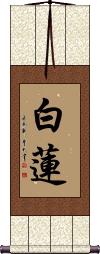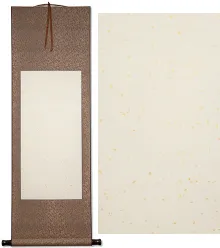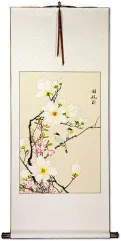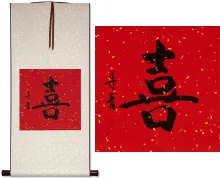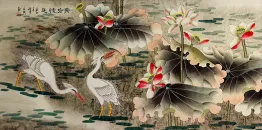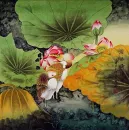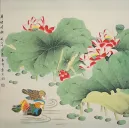Many custom options...
And formats...

White Lotus in Chinese / Japanese...
Buy a White Lotus calligraphy wall scroll here!
White Lotus
白蓮 is the title for the white lotus (flower) or a short name for the White Lotus society.
The white lotus represents purity or a pure heart and is often associated with Buddhism.
Notes: This can be the Japanese given name Byakuren. In the Buddhist context, the white lotus represented by these characters is originally puṇḍarīka in Sanskrit.
This in-stock artwork might be what you are looking for, and ships right away...
Gallery Price: $108.00
Your Price: $59.88
Gallery Price: $268.00
Your Price: $148.88
Gallery Price: $60.00
Your Price: $36.88
Gallery Price: $60.00
Your Price: $36.88
Gallery Price: $60.00
Your Price: $36.88
Gallery Price: $87.00
Your Price: $47.88
Gallery Price: $65.00
Your Price: $39.88
Gallery Price: $90.00
Your Price: $49.88
Gallery Price: $340.00
Your Price: $188.88
Gallery Price: $304.00
Your Price: $168.88
Gallery Price: $353.00
Your Price: $195.88
Not the results for White Lotus that you were looking for?
Below are some entries from our dictionary that may match your White Lotus search...
| Characters If shown, 2nd row is Simp. Chinese |
Pronunciation Romanization |
Simple Dictionary Definition |
月 see styles |
yuè yue4 yüeh runa るな |
More info & calligraphy: Moon(1) Moon; (2) month; (3) moonlight; (4) (See 衛星・1) (a) moon; natural satellite; (female given name) Runa candra, 旅達 (旅達羅); 旂陀羅; 戰達羅; 戰捺羅 the moon, called also 蘇摩 soma, from the fermented juice of asclepias acida used in worship, and later personified in association with the moon. It has many other epithets, e. g. 印度 Indu, incorrectly intp. as marked like a hare; 創夜神 Niśākara, maker of the night; 星宿王 Nakṣatranātha, lord of constellations; 喜懷之頭飾 the crest of Siva; 蓮華王 Kumuda-pati, lotus lord; 白馬主 Śvetavājin, drawn by (or lord of) white horses; 大白光神 Śītāṃśu, the spirit with white rays; 冷光神 Sitamarici, the spirit with cool rays; 鹿形神 Mṛgāṅka, the spirit with marks m form like a deer; 野兎形神 Śaśi, ditto like a hare. |
芬 see styles |
fēn fen1 fen fun ふん |
More info & calligraphy: Fynn(1) (abbreviation) (See 芬蘭・フィンランド) Finland; (adj-t,adv-to) (2) (archaism) fragrant; aromatic Fragrant; confused; translit. puṇ in芬陀利 (or芬陁利) puṇḍarīka. The white lotus, v. 分陀利. |
蓮 莲 see styles |
lián lian2 lien ren れん |
More info & calligraphy: Lotus(out-dated or obsolete kana usage) (1) (kana only) sacred lotus (Nelumbo nucifera); Indian lotus; lotus; (2) rose of Sharon (Hibiscus syriacus); (kana only) sacred lotus (Nelumbo nucifera); Indian lotus; lotus; (f,m,s) Ren puṇḍarīka, the lotus, especially the white lotus, Numphoea alba; padma, especially the Nelumbium speciosum; utpala, the Nymphoea coerulea, the blue lotus; kumuda, Nymphoea esculenta, white lotus, or N. rubra, red lotus; nīlotpala, N. cyanea, a blue lotus. The first four are called white, red, blue, and yellow lotuses; but the white lotus is generally meant unless otherwise specified. |
白蓮 白莲 see styles |
bái lián bai2 lian2 pai lien byakuren びゃくれん |
More info & calligraphy: White Lotus(1) white lotus; (2) purity; pure heart; (given name) Byakuren (白蓮華); 分陀利 puṇḍarīka, the white lotus. |
光宅 see styles |
guāng zhái guang1 zhai2 kuang chai Kōtaku |
Kuang-chai, name of the temple where 法雲 Fa-yun early in the sixth century wrote his commentary on the Lotus Sutra, which is known as the 光宅疏; 光宅 became his epithet. He made a division of four yāna from the Burning House parable, the goat cart representing the śrāvaka, the deer cart the pratyekabuddha, the ox-cart the Hīnayāna bodhisattva, and the great white ox-cart the Mahāyāna bodhisattva; a division adopted by T'ien-t'ai. |
十二 see styles |
shí èr shi2 er4 shih erh tooji とおじ |
twelve; 12 12; twelve; (given name) Tooji dvātriṃśa. Thirty-two. 三十二應 (or 三十二身) The thirty-two forms of Guanyin, and of Puxian, ranging from that of a Buddha to that of a man, a maid, a rakṣas; similar to the thirty-three forms named in the Lotus Sūtra. 三十二相三十二大人相 dvātriṃśadvaralakṣaṇa. The thirty-two lakṣaṇas, or physical marks of a cakravartī, or 'wheel-king', especially of the Buddha, i. e. level feet, thousand-spoke wheel-sign on feet, long slender fingers, pliant hands and feet, toes and fingers finely webbed, full-sized heels, arched insteps, thighs like a royal stag, hands reaching below the knees well-retracted male organ, height and stretch of arms equal, every hair-root dark coloured, body hair graceful and curly, golden-hued body, a 10 ft. halo around him, soft smooth skin, the 七處, i. e. two soles, two palms, two shoulders, and crown well rounded, below the armpits well-filled, lion-shaped body, erect, full shoulders, forty teeth, teeth white even and close, the four canine teeth pure white, lion-jawed, saliva improving the taste of all food, tongue long and broad, voice deep and resonant, eyes deep blue, eyelashes like a royal bull, a white ūrnā or curl between the eyebrows emitting light, an uṣṇīṣa or fleshy protuberance on the crown. These are from the 三藏法數 48, with which the 智度論 4, 涅盤經 28, 中阿含經, 三十ニ相經 generally agree. The 無量義經 has a different list. 三十二相經 The eleventh chapter of the 阿含經. 三十二相經願 The twenty-first of Amitābha's vows, v. 無量壽經. 三十三 trayastriṃśat. Thirty-three. 三十三天忉利天; 憺梨天, 多羅夜登陵舍; 憺利夜登陵奢; 憺利耶憺利奢 Trayastriṃśas. The Indra heaven, the second of the six heavens of form. Its capital is situated on the summit of Mt. Sumeru, where Indra rules over his thirty-two devas, who reside on thirty-two peaks of Sumeru, eight in each of the four directons. Indra's capital is called 殊勝 Sudarśana, 喜見城 Joy-view city. Its people are a yojana in height, each one's clothing weighs 六鐵 (1; 4 oz. ), and they live 1, 000 years, a day and night being equal to 100 earthly years. Eitel says Indra's heaven 'tallies in all its details with the Svarga of Brahminic mythology' and suggests that 'the whole myth may have an astronomical meaning', or be connected, with 'the atmosphere with its phenomena, which strengthens Koeppen's hypothesis explaining the number thirty-three as referring to the eight Vasus, eleven Rudras, twelve Ādityas, and two Aśvins of Vedic mythology'. In his palace called Vaijayanta 'Indra is enthroned with 1, 000 eyes with four arms grasping the vajra. There he revels in numberless sensual pleasures together with his wife Śacī... and with 119, 000 concubines with whom he associates by means of transformation'.; dvādaśa, twelve. |
四乘 see styles |
sì shèng si4 sheng4 ssu sheng shijō |
The goat, deer, and ox carts and the great white-bullock cart of the Lotus Sutra, see 四車. |
四車 四车 see styles |
sì chē si4 che1 ssu ch`e ssu che yotsuguruma よつぐるま |
(surname) Yotsuguruma The four vehicles 四乘 of the Lotus Sutra 譬喩品, i. e. goat, deer, bullock, and great white-bullock carts. |
天華 天华 see styles |
tiān huā tian1 hua1 t`ien hua tien hua yuki ゆき |
(Buddhist term) flowers that bloom in the heavens; paper flowers scattered before the Buddha's image; snow; (female given name) Yuki Deva, or divine, flowers, stated in the Lotus Sutra as of four kinds, mandāras, mahāmandāras, mañjūṣakas, and mahāmañjūṣakas, the first two white, the last two red. |
奔荼 see styles |
bēn tú ben1 tu2 pen t`u pen tu honda |
(奔荼利迦) puṇḍarīka, the white lotus, v. 分 or 芬; also the last of the eight great cold hells, v. 地獄. |
文殊 see styles |
wén shū wen2 shu1 wen shu monju もんじゅ |
Manjushri, the Bodhisattva of keen awareness (Buddhist term) Manjushri; Manjusri; Bodhisattva that represents transcendent wisdom; (p,s,f) Monju (文殊師利) Mañjuśrī 滿殊尸利 -later 曼殊室利. 文殊 is also used for Mañjunātha, Mañjudeva, Mañjughoṣa, Mañjuṣvara, et al. T., hjamdpal; J., Monju. Origin unknown; presumably, like most Buddhas and bodhisattvas, an idealization of a particular quality, in his case of Wisdom. Mañju is beautiful, Śrī; good fortune, virtue, majesty, lord, an epithet of a god. Six definitions are obtained from various scriptures: 妙首 (or 頭 ) wonderful or beautiful) head; 普首 universal head; 濡首 glossy head (probably a transliteration); 敬首 revered head; 妙德 wonderful virtue (or power); 妙吉祥 wonderfully auspicious; the last is a later translation in the 西域記. As guardian of wisdom 智慧 he is often placed on Śākyamuni's left, with 普顯 on the right as guardian of law 理, the latter holding the Law, the former the wisdom or exposition of it; formerly they held the reverse positions. He is often represented with five curls or waves to his hair indicating the 五智 q. v. or the five peaks; his hand holds the sword of wisdom and he sits on a lion emblematic of its stern majesty: but he has other forms. He is represented as a youth, i. e. eternal youth. His present abode is given as east of the universe, known as 淸涼山 clear and cool mountain, or a region 寶住 precious abode, or Abode of Treasures, or 寶氏 from which he derives one of his titles, 寶相如來. One of his dhāraṇīs prophesies China as his post-nirvāṇa realm. In past incarnations he is described as being the parent of many Buddhas and as having assisted the Buddha into existence; his title was 龍種上佛 the supreme Buddha of the nāgas, also 大身佛 or 神仙佛; now his title is 歡喜藏摩尼寶精佛 The spiritual Buddha who joyfully cares for the jewel: and his future title is to be 普現佛 Buddha universally revealed. In the 序品 Introductory Chapter of the Lotus Sutra he is also described as the ninth predecessor or Buddha-ancestor of Śākyamuni. He is looked on as the chief of the Bodhisattvas and represents them, as the chief disciple of the Buddha, or as his son 法王子. Hīnayāna counts Śāriputra as the wisest of the disciples, Mahāyāna gives Mañjuśrī the chief place, hence he is also styled 覺母 mother, or begetter of understanding. He is shown riding on either a lion or a peacock, or sitting on a white lotus; often he holds a book, emblem of wisdom, or a blue lotus; in certain rooms of a monastery he is shown as a monk; and he appears in military array as defender of the faith. His signs, magic words, and so on, are found in various sutras. His most famous centre in China is Wu-tai shan in Shansi. where he is the object of pilgrimages, especially of Mongols. The legends about him are many. He takes the place in Buddhism of Viśvakarman as Vulcan, or architect, of the universe. He is one of the eight Dhyāni-bodhisattvas, and sometimes has the image of Akṣobhya in his crown. He was mentioned in China as early as the fourth century and in the Lotus Sutra he frequently appears, especially as the converter of the daughter of the Dragon-king of the Ocean. He has five messengers 五使者 and eight youths 八童子 attending on him. His hall in the Garbhadhātu maṇḍala is the seventh, in which his group numbers twenty-five. His position is northeast. There are numerous sutras and other works with his name as title, e. g. 文殊師利問菩提經 Gayaśīrṣa sūtra, tr. by Kumārajīva 384-417: and its 論 or .Tīkā of Vasubandhu, tr. by Bodhiruci 535. see list in B. N. |
普賢 普贤 see styles |
pǔ xián pu3 xian2 p`u hsien pu hsien fugen ふげん |
Samantabhadra, the Buddhist Lord of Truth Samantabhadra (bodhisattva); Universal Compassion; (place-name) Fugen Samantabhadra, Viśvabhadra; cf. 三曼 Universal sagacity, or favour; lord of the 理 or fundamental law, the dhyāna, and the practice of all Buddhas. He and Mañjuśrī are the right- and left-hand assistants of Buddha, representing 理 and 智 respectively. He rides on a white elephant, is the patron of the Lotus Sūtra and its devotees, and has close connection with the Huayan Sūtra. His region is in the east. The esoteric school has its own special representation of him, with emphasis on the sword indicative of 理 as the basis of 智. He has ten vows. |
火宅 see styles |
huǒ zhái huo3 zhai2 huo chai kataku かたく |
{Buddh} this world of suffering The parable of the burning house; one of the 'seven parables' in the Lotus Sutra 譬喩品, that of the burning house from which the owner tempts his heedless children by the device of the three kinds of carts— goat, deer, and bullock, especially a white-bullock cart i. e. Mahāyāna. |
舍利 see styles |
shè lì she4 li4 she li shari |
(Buddhism) relic found in the cremated ashes of Buddhists (from Sanskrit "śarīra") (1) śārī, śārikā; a bird able to talk, intp. variously, but, M. W. says the mynah. Śārikā was the name of Śāriputra's mother, because her eyes were bright and clever like those of a mynah; there are other interpretation (2) śarīra(m). 設利羅 (or 室利羅); 實利; 攝 M004215 藍 Relics or ashes left after the cremation of a buddha or saint; placed in stupas and worhipped. The white represent bones; the black, hair; and the red, flesh. Also called dhātu-śarīra or dharma-śarīra. The body, a dead body. The body looked upon as dead by reason of obedience to the discipline, meditation, and wisdom. The Lotus Sutra and other sutras are counted as relics, Śākyamuni's relics are said to have amounted to 八斛四斗 84 pecks, for which Aśoka is reputed to have built in one day 84,000 stupas; but other figures are also given. śarīra is also intp. by grains of rice, etc., and by rice as food. |
芬陀 see styles |
fēn tuó fen1 tuo2 fen t`o fen to funda |
white lotus flower |
蓮宗 莲宗 see styles |
lián zōng lian2 zong1 lien tsung Renshū |
see 淨土宗|净土宗[Jing4 tu3 zong1] The Lotus sect founded by 慧遠 Huiyuan circa A.D. 390 at his monastery, in which was a 自蓮池 white lotus pond. It has no connection with the White Lily Secret Society which arose during the Mongol or Yuan dynasty. The Lotus sect is traced to the awakening of Huiyuan by the reading of the Prajñāpāramitā sūtra. He then turned his attention to calling on the name of Buddha to obtain salvation direct to his Pure Land. The school became that of the Amitābha or Pure-land sect, which in later years developed into the principal Buddhist cult in the Far East. |
蓮社 莲社 see styles |
lián shè lian2 she4 lien she Rensha |
The White Lotus sect, idem 蓮宗. |
露牛 see styles |
lù niú lu4 niu2 lu niu rogo |
The great white ox and oxcart revealed in the open, i.e. the Mahāyāna, v. Lotus Sūtra. |
大刀會 大刀会 see styles |
dà dāo huì da4 dao1 hui4 ta tao hui |
Great Sword Society, an offshoot of the White Lotus in the late Qing dynasty, involved in anti-Western activity at the time of the Boxer rebellion |
大白衣 see styles |
dà bái yī da4 bai2 yi1 ta pai i Dai Byakue |
Pāṇḍaravāsinī, the great white-robed one, a form of Guanyin all in white, with white lotus, throne, etc., also called 白衣 or 白處觀音. |
大蓮華 大莲华 see styles |
dà lián huá da4 lian2 hua2 ta lien hua dai renge |
puṇḍarīka, 分陀利; 芬利; 奔茶 the great white lotus; the last of the eight cold hells is so called. |
屈摩羅 屈摩罗 see styles |
qū mó luó qu1 mo2 luo2 ch`ü mo lo chü mo lo kutsumara |
屈滿囉 A lotus bud.; the budding phase of the white lotus (puṇḍarīka). |
拘勿頭 拘勿头 see styles |
jū wù tóu ju1 wu4 tou2 chü wu t`ou chü wu tou kumotsuzu |
white lotus |
拘牟頭 拘牟头 see styles |
jū móu tóu ju1 mou2 tou2 chü mou t`ou chü mou tou kumuzu |
white lotus |
拘物度 see styles |
jū wù dù ju1 wu4 du4 chü wu tu kumotsudo |
white lotus |
拘物陀 see styles |
jū wù tuó ju1 wu4 tuo2 chü wu t`o chü wu to kumotsuda |
white lotus |
拘物頭 拘物头 see styles |
jū wù tóu ju1 wu4 tou2 chü wu t`ou chü wu tou kumotsuzu |
kumuda; also 拘物陀; 拘物度; 拘勿頭 (or 拘勿投); 拘牟頭 ( or拘貿頭or 拘某頭or 拘那頭); 拘母陀; 句文羅; 倶勿頭; 屈摩羅; 究牟陀 a lotus; an opening lotus; but kumuda refers especially to the esculent white lotus. M. W. |
拘貿頭 拘贸头 see styles |
jū mào tóu ju1 mao4 tou2 chü mao t`ou chü mao tou kubōzu |
white lotus |
白蓮教 白莲教 see styles |
bái lián jiào bai2 lian2 jiao4 pai lien chiao byakurenkyou / byakurenkyo びゃくれんきょう |
White Lotus society White Lotus Society The White Lily Society, set up near the end of the Yuan dynasty, announcing the coming of Maitreya, the opening of his white lily, and the day of salvation at hand. It developed into a revolution which influenced the expulsion of the Mongols and establishment of the Ming dynasty. Under the Qing dynasty it was resurrected under a variety of names, and caused various uprisings. |
白蓮社 白莲社 see styles |
bái lián shè bai2 lian2 she4 pai lien she byakurensha びゃくれんしゃ |
(surname) Byakurensha (白蓮華社) ; 白蓮之交; 蓮社 A society formed early in the fourth century A. D. by 慧遠 Huiyuan, who with 123 notable literati, swore to a life of purity before the image of Amitābha, and planted white lotuses in symbol. An account of seven of its succeeding patriarchs is given in the 佛祖統紀 26; as also of eighteen of its worthies. |
Click here for more White Lotus results from our dictionary
The following table may be helpful for those studying Chinese or Japanese...
| Title | Characters | Romaji (Romanized Japanese) | Various forms of Romanized Chinese | |
| White Lotus | 白蓮 白莲 | byakuren | bái lián / bai2 lian2 / bai lian / bailian | pai lien / pailien |
| In some entries above you will see that characters have different versions above and below a line. In these cases, the characters above the line are Traditional Chinese, while the ones below are Simplified Chinese. | ||||
Successful Chinese Character and Japanese Kanji calligraphy searches within the last few hours...
